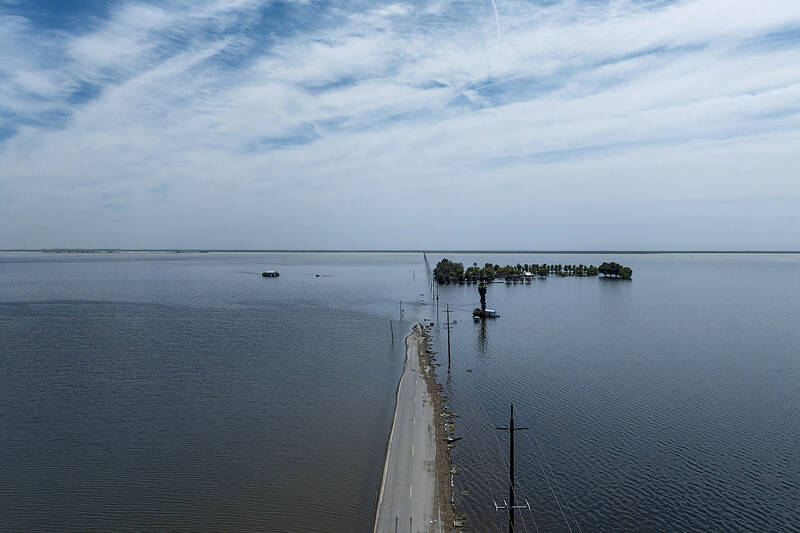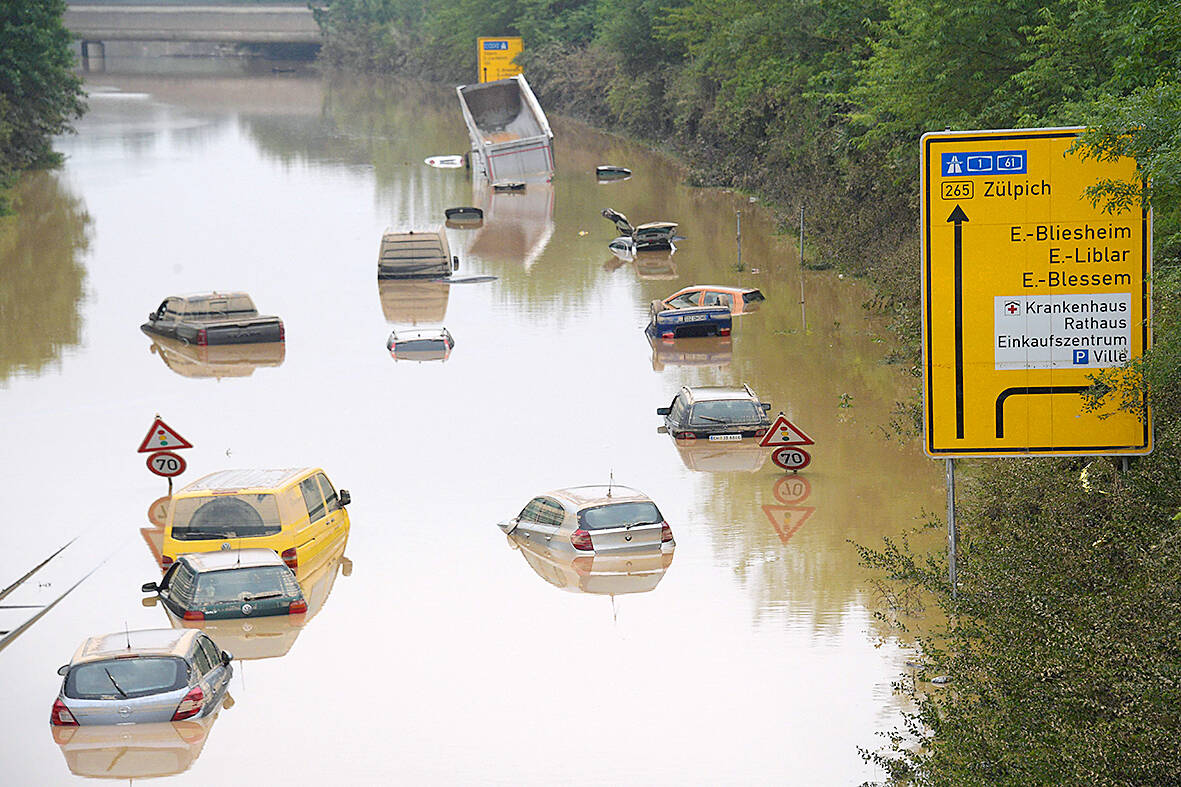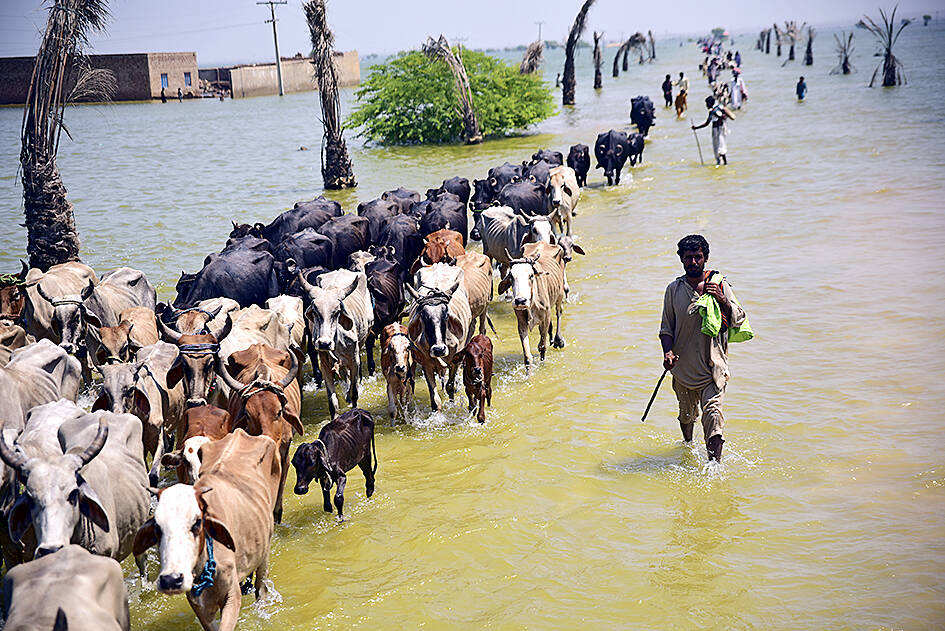A warming world is transforming some major snowfalls into extreme rain over mountains instead, somehow worsening both dangerous flooding like the type that devastated Pakistan last year as well as long-term water shortages, a new study found.
Using rain and snow measurements since 1950 and computer simulations for future climate, scientists calculated that for every degree Celsius the world warms, extreme rainfall at higher elevation increases by 15 percent according to a study published Wednesday in the journal Nature.
Heavy rain in mountains causes a lot more problems than big snow, including flooding, landslides and erosion, scientists said. And the rain isn’t conveniently stored away like snowpack that can recharge reservoirs in spring and summer.

Photo: AP
“It is not just a far-off problem that is projected to occur in the future, but the data is actually telling us that it’s already happening and we see that in the data over the past few decades,” said lead author Mohammed Ombadi, a Lawrence Berkeley National Laboratory hydrologist and climate scientist.
As the world has warmed to the brink of the 1.5 degree Celsius internationally agreed threshold to stem the worst effects of climate change, this study shows “every degree (Celsius) matters because it comes with an additional 15 percent increase” in extreme rain over mountains, Ombadi said. That per-degree rainfall boost in the mountains is more than twice the increase the rest of the world gets from warming air holding more water.
The study looked at only the heaviest rains each year over six decades in the Northern Hemisphere, finding that as altitude rose, so did the turbocharging of rain. The biggest increase in rains were noticed at about 3,000m. That includes much of the American West, where Ombadi said “it’s very pronounced,” as well as parts of the Appalachian Mountains. Another big hotspot in Asia is the Himalayas, Tian Shan and Hindu Kush mountains, with the Alps also affected.

Photo: AFP
About one in four people on Earth live in an area close enough to the mountains or downhill that extreme rain and flooding would hit them, Ombadi said.
It means more of the type of flooding off the mountains like the one that killed more than 1,700 people in Pakistan and put one-third of the country underwater, Ombadi said. But he noted that they haven’t studied Pakistan’s 2022 floods precisely so there may be some small differences.
The study makes sense and “the implications are serious,” said UCLA climate hydrologist Park Williams, who wasn’t part of the research. Scientists expect more precipitation with warmer temperatures, but heavy snow’s flooding impact is lessened because it takes time to melt and it’s easier to monitor snowpack to see what’s happening, he said.

Photo: AP
“But as the proportion of mountain precipitation falling as snow decreases, flood hazards may enhance especially rapidly,” Williams said.
In the American West it hits hard in different ways, said study co-author Charuleka Varadharajan, a hydrologist.
“This kind of extreme rainfall is going to make the floods worse. And then you’ve got to figure out where is that water going?” she said, noting some of the flooding woes the West already dealt with this year in the wake of a series of atmospheric rivers and melting snowpack.
The flooding also can hurt food production, Ombadi said. He pointed to California Department of Agriculture estimates of US$89 million in crop and livestock losses from torrential rains in 1997.
But in the long term, another problem is water supply. When the West gets heavy snowfall in the winter, that snow melts slowly in spring and summer, filling reservoirs where it can be useful when it’s needed later.
“It’s going to decrease your snow, your water supply in the future,” Varadharajan said. “You’re going to have more short-term runoff leading to more floods and less snowpack that recharges the groundwater and the groundwater is ultimately what helps maintain stream flows.”
“These mountainous systems are supplying most of the water in the West so any decreases in water supply would be pretty significant in terms of water management,” she said.
In times of drought — and much of the West is coping with a more than 20 year-long megadrought — water managers like to keep water levels high in reservoirs, which they can do with heavy snowpacks because it melts slowly, Williams said. But they can’t do that with heavy rainfall.
So as warming causes rainier extremes, society is going to have to choose between cutting water use because of low water levels in reservoirs to absorb a possible large sudden mountain runoff event or build expensive new reservoirs, Williams said.

On April 26, The Lancet published a letter from two doctors at Taichung-based China Medical University Hospital (CMUH) warning that “Taiwan’s Health Care System is on the Brink of Collapse.” The authors said that “Years of policy inaction and mismanagement of resources have led to the National Health Insurance system operating under unsustainable conditions.” The pushback was immediate. Errors in the paper were quickly identified and publicized, to discredit the authors (the hospital apologized). CNA reported that CMUH said the letter described Taiwan in 2021 as having 62 nurses per 10,000 people, when the correct number was 78 nurses per 10,000

As Donald Trump’s executive order in March led to the shuttering of Voice of America (VOA) — the global broadcaster whose roots date back to the fight against Nazi propaganda — he quickly attracted support from figures not used to aligning themselves with any US administration. Trump had ordered the US Agency for Global Media, the federal agency that funds VOA and other groups promoting independent journalism overseas, to be “eliminated to the maximum extent consistent with applicable law.” The decision suddenly halted programming in 49 languages to more than 425 million people. In Moscow, Margarita Simonyan, the hardline editor-in-chief of the

Six weeks before I embarked on a research mission in Kyoto, I was sitting alone at a bar counter in Melbourne. Next to me, a woman was bragging loudly to a friend: She, too, was heading to Kyoto, I quickly discerned. Except her trip was in four months. And she’d just pulled an all-nighter booking restaurant reservations. As I snooped on the conversation, I broke out in a sweat, panicking because I’d yet to secure a single table. Then I remembered: Eating well in Japan is absolutely not something to lose sleep over. It’s true that the best-known institutions book up faster

Though the total area of Penghu isn’t that large, exploring all of it — including its numerous outlying islands — could easily take a couple of weeks. The most remote township accessible by road from Magong City (馬公市) is Siyu (西嶼鄉), and this place alone deserves at least two days to fully appreciate. Whether it’s beaches, architecture, museums, snacks, sunrises or sunsets that attract you, Siyu has something for everyone. Though only 5km from Magong by sea, no ferry service currently exists and it must be reached by a long circuitous route around the main island of Penghu, with the